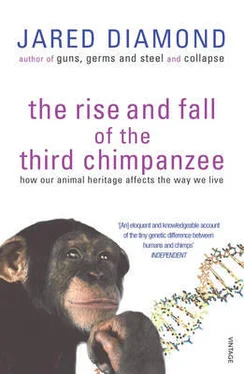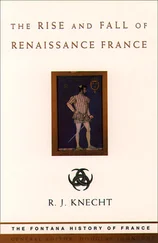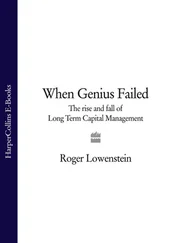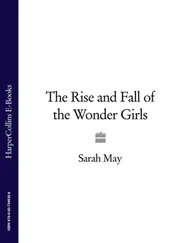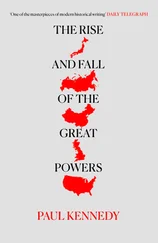Jared Diamond - The rise and fall of the third chimpanzee
Здесь есть возможность читать онлайн «Jared Diamond - The rise and fall of the third chimpanzee» весь текст электронной книги совершенно бесплатно (целиком полную версию без сокращений). В некоторых случаях можно слушать аудио, скачать через торрент в формате fb2 и присутствует краткое содержание. Год выпуска: 1991, ISBN: 1991, Издательство: RADIUS, Жанр: Биология, на английском языке. Описание произведения, (предисловие) а так же отзывы посетителей доступны на портале библиотеки ЛибКат.
- Название:The rise and fall of the third chimpanzee
- Автор:
- Издательство:RADIUS
- Жанр:
- Год:1991
- ISBN:0-09-174268-4
- Рейтинг книги:4 / 5. Голосов: 1
-
Избранное:Добавить в избранное
- Отзывы:
-
Ваша оценка:
- 80
- 1
- 2
- 3
- 4
- 5
The rise and fall of the third chimpanzee: краткое содержание, описание и аннотация
Предлагаем к чтению аннотацию, описание, краткое содержание или предисловие (зависит от того, что написал сам автор книги «The rise and fall of the third chimpanzee»). Если вы не нашли необходимую информацию о книге — напишите в комментариях, мы постараемся отыскать её.
The rise and fall of the third chimpanzee — читать онлайн бесплатно полную книгу (весь текст) целиком
Ниже представлен текст книги, разбитый по страницам. Система сохранения места последней прочитанной страницы, позволяет с удобством читать онлайн бесплатно книгу «The rise and fall of the third chimpanzee», без необходимости каждый раз заново искать на чём Вы остановились. Поставьте закладку, и сможете в любой момент перейти на страницу, на которой закончили чтение.
Интервал:
Закладка:
W.P. Lehmann and L. Zgusta provide and discuss a sample of reconstructed proto-Indo-European in their chapter 'Schleicher's tale after a century', pp. 455—66 in Studies in Diachronic, Synchronic, and Typological Linguistics, edited by Bela Brogyanyi (Benjamins, Amsterdam, 1979).
The references to the domestication and importance of horses cited under Chapter Fourteen are also relevant to the role of horses in the Indo-European expansion. Papers specifically on this subject are by David Anthony, 'The "Kurgan culture", Indo-European origins and the domestication of the horse: a reconsideration', Current Anthropology 27, pp. 291–313 (1986); and by David Anthony and Dorcas Brown, The origins of horseback riding', Antiquity 65, pp. 22–38 (1991).
Chapter 16: In Black and White
Three books providing general surveys of genocide are by Irving Horowitz, Genocide: State Power and Mass Murder (Transaction Books, New Brunswick, 1976); Leo Kuper, The Pity of it All (Gerald Duck-worth, London, 1977); and Leo Kuper, Genocide: Its Political Use in the 20th Century (Yale University Press, New
Haven, 1981). A gifted psychiatrist, Robert J. Lifton, has published studies of the psychological effects of genocide on its perpetrators and survivors, including Death in Life:
Survivors of Hiroshima (Random House, New York, 1967) and The Broken Connection
(Simon and Schuster, New York, 1979).
Books that describe the extermination of the Tasmanians and other native Australian groups include N.J.B. Plomley, Friendly Mission: The Tasmanian Journals and Papers of George
Augustus Robinson 1829–1834 (Tasmanian Historical Research Association, Hobart, 1966);
C.D. Rowley, The Destruction of Aboriginal Society, Vol. I (Australian National University
Press, Canberra, 1970); and Lyndall Ryan, The Aboriginal Tasmanians (University of
Queensland Press, St. Lucia, 1981). Patricia Cobern's letter indignantly denying that
Australian whites exterminated the Tasmanians has been reprinted as an appendix to the book by J. Peter White and James F. O'Connell, A Prehistory of Australia, New Guinea, and Sahul
(Academic Press, New York, 1982).
Among the many books detailing the extermination of American Indians by white settlers are
Wilcomb E. Washburn, 'The moral and legal justification for dispossessing the Indians', pp. 15–32 in Seventeenth Century America, edited by James Morton Smith (University of North Carolina Press, Chapel Hill, 1959); Alvin M. Josephy, Jnr, The American Heritage Book of Indians (Simon and Schuster, New York, 1961); Howard Peckham and Charles Gibson, Attitudes of Colonial Powers Towards the American Indian (University of Utah Press, Salt Lake City, 1969); Francis Jennings, The Invasion of America: Indians, Colonialism, and the
Cant of Conquest (University of North Carolina Press, Chapel Hill, 1975); Wilcomb E.
Washburn, The Indian in America (Harper and Row, New York, 1975); Arrell Morgan
Gibson, The American Indian, Prehistory to the Present (Heath, Lexington, Massachusetts, 1980); and Wilbur H. Jacobs, Dispossessing the American Indian (University of Oklahoma
Press, Norman, 1985). The extermination of the Yahi Indians, and the survival of Ishi, are the subjects of Theodora Kroeber's classic book Ishi in Two Worlds: A Biography of the Last
Wild Indian in North America (University of California Press, Berkeley, 1961). The extermination of Brazil's Indians is treated by Sheldon Davis, Victims of the Miracle
(Cambridge University Press, Cambridge, 1977).
Genocide under Stalin is described in books by Robert Conquest, including The Harvest of Sorrow
(Oxford University Press, New York, 1986).
Accounts of murder and mass murder of animals by other animals of the same species are given by
E.O. Wilson, Sociobiology (Harvard University Press, Cambridge, 1975); Cynthia Moss, Portraits in the Wild, 2nd edition
(University of Chicago Press, Chicago, 1982); and Jane Goodall, The Chimpanzees of Gombe
(Harvard University Press, Cambridge, 1986).
Chapter 17: The Golden Age that Never Was
Extinction of animals in the Late Pleistocene and Early Recent era are described comprehensively in the book edited by Paul Martin and Richard Klein, Quaternary
Extinctions (University of Arizonia Press, Tucson, 1984). For the history of deforestation, see
John Perlin's book A Forest Journey (Norton, New York, 1989).
Comprehensive accounts of New Zealand's plants, animals, geology, and climate will be found in a book edited by G. Kuschel, Biogeography and Ecology in New Zealand (Junk,
V.T. Hague, 1975). New Zealand examples of extinction are summarized in chapters 32–34 of the book by Martin and Klein, cited above. Moas are the subject of a supplement to the
New Zealand Journal of Ecology, Vol. XII (1989); see especially the articles by Richard
Holdaway on pp. 11–25, and by lan Atkinson and R.M. Greenwood on pp. 67–96. Other key articles relevant to moas are by G. Caughley, 'The colonization of New Zealand by the
Polynesians', Journal of the Royal Society of New Zealand 18, pp. 245-70 (1988), and by A.
Anderson, 'Mechanics of overkill in the extinction of New Zealand moas', Journal of
Archaeological Science 16, pp. 137–151 (1989).
Examples of extinction in Madagascar and Hawaii are described in Chapters 26 and 35 respectively of the book by Martin and Klein, cited above. The Henderson Island story is told by David Steadman and Storrs Olson, 'Bird remains from an archaeological site on Henderson Island, South Pacific: man-caused extinctions on an «uninhabited» island', Proceedings of the National Academy of Sciences 82, pp. 6191-95 (1985). See under suggested reading for Chapter Eighteen for accounts of species' extinction in the Americas. The grisly end of Easter Island civilization is recounted by Patrick V. Kirch in his book The Evolution of the Polynesian Chiefdoms (Cambridge University Press, Cambridge, 1984). Easter's deforestation was reconstructed by J. Flenley, 'Stratigraphic evidence of environmental change on Easter Island', Asian Perspectives 22, pp. 33–40 (1979), and by J. Henley and S. King, 'Late Quaternary pollen records from Easter Island', Nature 307, pp. 47–50 (1984).
Some accounts of the rise and fall of Anasazi settlement at Chaco Canyon are J.L. Betancourt and T.R. Van Devender, 'Holocene vegetation in Chaco Canyon, New Mexico', Science 214, pp. 656-58—349—(1981); M.L. Samuels and J.L. Betancourt, 'Modeling the long-term effects of fuelwood harvests on pinyon-juniper woodlands', Environmental Management 6, pp. 505-15 (1982);J.L. Betancourt etal, 'Prehistoric long-distance transport of construction beams, Chaco Canyon, New Mexico', American Antiquity 51, pp. 370-75 (1986); Kendrick Frazier, People of Chaco: A Canyon and its Culture (Norton, New York, 1986); and Alden C. Hayes et al, Archaeological Surveys of Chaco Canyon (University of New Mexico Press, Albuquerque, 1987).
Everything that anyone would want to know about Packrat Middens is described in the eponymous book by Julio Betancourt, Thomas Van Devender, and Paul Martin (University of Arizona Press, Tucson, 1990). In particular, Chapter Nineteen of that book analyses the hyrax middens from Petra.
The possible link between environmental damage and the decline of Greek civilization is explored by K.O. Pope and T.H. Van Andel in'Late Quaternary civilization and soil formation in the southern Argolid: its history, causes and archaeological implications', Journal of Archaeological Science 11, pp. 281–306 (1984); T.H. van Andel etal, 'Five thousand years of land use and abuse in the southern Argolid', Hesperia 55, pp. 103-28 (1986); and C. Runnels and T.H. van Andel, 'The evolution of settlement in the southern Argolid, Greece: an economic explanation', Hesperia 56, pp. 303-34 (1987).
Читать дальшеИнтервал:
Закладка:
Похожие книги на «The rise and fall of the third chimpanzee»
Представляем Вашему вниманию похожие книги на «The rise and fall of the third chimpanzee» списком для выбора. Мы отобрали схожую по названию и смыслу литературу в надежде предоставить читателям больше вариантов отыскать новые, интересные, ещё непрочитанные произведения.
Обсуждение, отзывы о книге «The rise and fall of the third chimpanzee» и просто собственные мнения читателей. Оставьте ваши комментарии, напишите, что Вы думаете о произведении, его смысле или главных героях. Укажите что конкретно понравилось, а что нет, и почему Вы так считаете.
